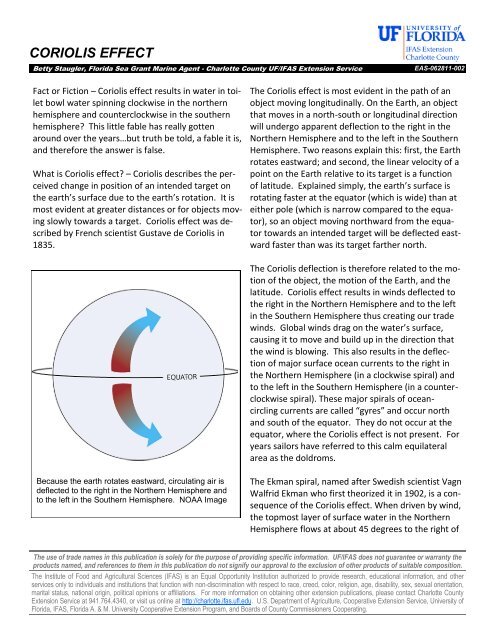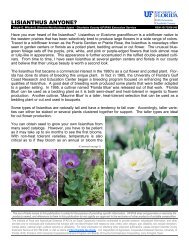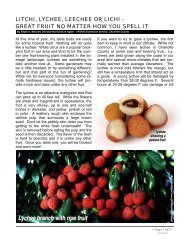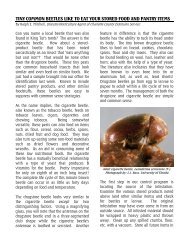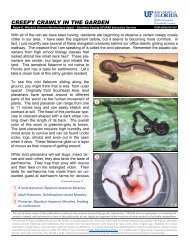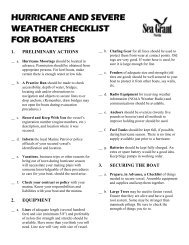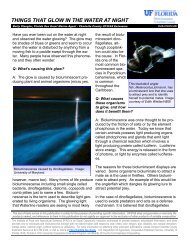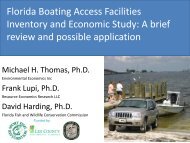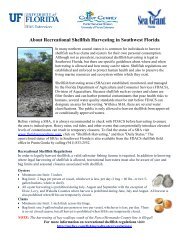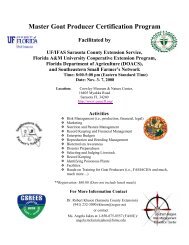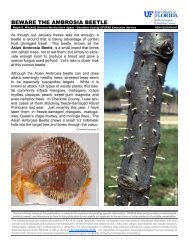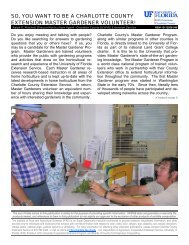coriolis effect - Charlotte County Cooperative Extension - University ...
coriolis effect - Charlotte County Cooperative Extension - University ...
coriolis effect - Charlotte County Cooperative Extension - University ...
Create successful ePaper yourself
Turn your PDF publications into a flip-book with our unique Google optimized e-Paper software.
CORIOLIS EFFECT<br />
Betty Staugler, Florida Sea Grant Marine Agent - <strong>Charlotte</strong> <strong>County</strong> UF/IFAS <strong>Extension</strong> Service<br />
EAS-062811-002<br />
Fact or Fiction – Coriolis <strong>effect</strong> results in water in toilet<br />
bowl water spinning clockwise in the northern<br />
hemisphere and counterclockwise in the southern<br />
hemisphere This little fable has really gotten<br />
around over the years…but truth be told, a fable it is,<br />
and therefore the answer is false.<br />
What is Coriolis <strong>effect</strong> – Coriolis describes the perceived<br />
change in position of an intended target on<br />
the earth’s surface due to the earth’s rotation. It is<br />
most evident at greater distances or for objects moving<br />
slowly towards a target. Coriolis <strong>effect</strong> was described<br />
by French scientist Gustave de Coriolis in<br />
1835.<br />
The Coriolis <strong>effect</strong> is most evident in the path of an<br />
object moving longitudinally. On the Earth, an object<br />
that moves in a north-south or longitudinal direction<br />
will undergo apparent deflection to the right in the<br />
Northern Hemisphere and to the left in the Southern<br />
Hemisphere. Two reasons explain this: first, the Earth<br />
rotates eastward; and second, the linear velocity of a<br />
point on the Earth relative to its target is a function<br />
of latitude. Explained simply, the earth’s surface is<br />
rotating faster at the equator (which is wide) than at<br />
either pole (which is narrow compared to the equator),<br />
so an object moving northward from the equator<br />
towards an intended target will be deflected eastward<br />
faster than was its target farther north.<br />
The Coriolis deflection is therefore related to the motion<br />
of the object, the motion of the Earth, and the<br />
latitude. Coriolis <strong>effect</strong> results in winds deflected to<br />
the right in the Northern Hemisphere and to the left<br />
in the Southern Hemisphere thus creating our trade<br />
winds. Global winds drag on the water’s surface,<br />
causing it to move and build up in the direction that<br />
the wind is blowing. This also results in the deflection<br />
of major surface ocean currents to the right in<br />
the Northern Hemisphere (in a clockwise spiral) and<br />
to the left in the Southern Hemisphere (in a counterclockwise<br />
spiral). These major spirals of oceancircling<br />
currents are called “gyres” and occur north<br />
and south of the equator. They do not occur at the<br />
equator, where the Coriolis <strong>effect</strong> is not present. For<br />
years sailors have referred to this calm equilateral<br />
area as the doldroms.<br />
Because the earth rotates eastward, circulating air is<br />
deflected to the right in the Northern Hemisphere and<br />
to the left in the Southern Hemisphere. NOAA Image<br />
The Ekman spiral, named after Swedish scientist Vagn<br />
Walfrid Ekman who first theorized it in 1902, is a consequence<br />
of the Coriolis <strong>effect</strong>. When driven by wind,<br />
the topmost layer of surface water in the Northern<br />
Hemisphere flows at about 45 degrees to the right of<br />
The use of trade names in this publication is solely for the purpose of providing specific information. UF/IFAS does not guarantee or warranty the<br />
products named, and references to them in this publication do not signify our approval to the exclusion of other products of suitable composition.<br />
The Institute of Food and Agricultural Sciences (IFAS) is an Equal Opportunity Institution authorized to provide research, educational information, and other<br />
services only to individuals and institutions that function with non-discrimination with respect to race, creed, color, religion, age, disability, sex, sexual orientation,<br />
marital status, national origin, political opinions or affiliations. For more information on obtaining other extension publications, please contact <strong>Charlotte</strong> <strong>County</strong><br />
<strong>Extension</strong> Service at 941.764.4340, or visit us online at http://charlotte.ifas.ufl.edu. U.S. Department of Agriculture, <strong>Cooperative</strong> <strong>Extension</strong> Service, <strong>University</strong> of<br />
Florida, IFAS, Florida A. & M. <strong>University</strong> <strong>Cooperative</strong> <strong>Extension</strong> Program, and Boards of <strong>County</strong> Commissioners Cooperating.
CORIOLIS EFFECT<br />
June 28, 2011<br />
the wind direction. Deeper layers of water respond<br />
to the friction of the layer above and also deflect to<br />
the right but at a slower speed. Each subsequent<br />
deeper layer slides horizontally over the one above it<br />
like a deck of cards creating a spiral <strong>effect</strong>, until the<br />
movement ceases at a depth of about 100 meters<br />
(330 feet). Because the deeper layers of water move<br />
more slowly than the shallower layers, they tend to<br />
“twist around” and flow opposite to the surface current.<br />
So why doesn’t Coriolis hold true for a toilet The<br />
rotation of the Earth is very small: only one rotation<br />
per day. The water in a toilet might make a several<br />
rotations a second so its rotation rate is many thousand<br />
times greater than that of the Earth. As a result<br />
Coriolis force is orders of magnitude smaller than any<br />
of the forces involved in a flushing toilet. The Coriolis<br />
force is so small, that it plays no role in determining<br />
the direction of rotation of a draining toilet.<br />
Eckman’s Spiral occurs as a consequence of<br />
Coriolis. NOAA Image<br />
Source: NOAA Ocean Service Education<br />
http://oceanservice.noaa.gov/education/kits/currents/05currents1.html<br />
BETTY STAUGLER<br />
Florida Sea Grant Marine Agent<br />
Staugler@ufl.edu<br />
CHARLOTTE COUNTY UF/IFAS EXTENSION SERVICE<br />
25550 Harbor View Road, Suite 3 - Port <strong>Charlotte</strong>, Florida 33980<br />
941.764.4340 - 941.764.4343 (fax) - http://charlotte.ifas.ufl.edu


